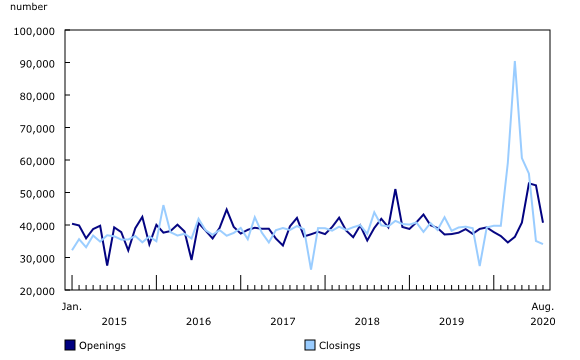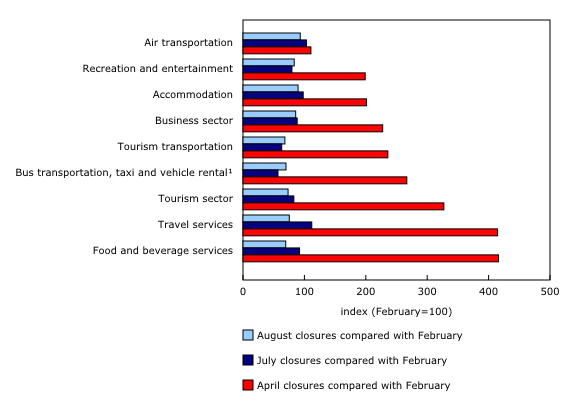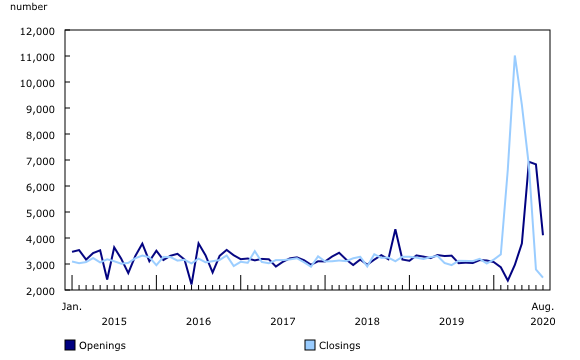Monthly estimates of business openings and closures, August 2020
Archived Content
Information identified as archived is provided for reference, research or recordkeeping purposes. It is not subject to the Government of Canada Web Standards and has not been altered or updated since it was archived. Please "contact us" to request a format other than those available.
Released: 2020-11-26
According to estimates, the number of business closures edged down in August, as COVID-19 restrictions continued to ease. In August, 34,126 business closures were observed in the Canadian business sector, 2.7% less than in July and 14.2% lower than prior to the COVID-19 pandemic in February. This decline in closures may reflect the fact that businesses that were least able to adapt to the pandemic had already exited the economy in preceding months. For the second consecutive month, the number of business openings (40,697) exceeded the number of business closures. Nevertheless, the number of active businesses was 9.0% lower in August than in February.
The August estimates for the experimental series on monthly openings and closings are now available. The series include monthly estimates of the number of business openings and closures, continuing businesses, and active businesses from January 2015 to August 2020. In addition, new series for the tourism sector and its component industries are now available.
Most provinces and territories, and most industries continued to report fewer business closures in August. However, Prince Edward Island and New Brunswick reported an increase in business closures. Among industries, business closures rose in finance and insurance and management of companies and enterprises, and transportation and warehousing. Such increases are consistent with monthly fluctuations seen in previous years.
New series on the tourism industries now available
The experimental series on monthly openings and closures now include monthly estimates of the number of business openings and closures, continuing businesses, and active businesses in the tourism industries at the national level from January 2015 to August 2020. These industries are based on Statistics Canada's Canadian Tourism Satellite Account industry aggregations and include air transportation; water transportation; rail, scenic and sightseeing transportation; bus transportation, taxi and limousine services, and vehicle rental; accommodation; food and beverage services; recreation and entertainment; and travel services.
The new series show that the tourism industries are among those most affected by the COVID-19 pandemic. While business closures doubled in the business sector from February to April 2020, the tourism sector as a whole had 11,020 closures in April, more than triple the number of closures in February. The most affected industries in the tourism sector were food and beverage services (+316.2%; +6,009), travel services (+314.6%; +310) and bus transportation, taxi and limousine services, and vehicle rental (+166.8%; +296). While business closures also increased in air transportation from February to April, the increase was smaller than in all other tourism industries. Since the peak in business closures in April, closures have declined across the tourism industries. As of August, business closures were below the pre-COVID level posted in February in all tourism industries.
The number of business openings in the tourism sector exceeded that of business closures in each of the last three months. Despite the openings, the number of active businesses in the tourism sector in August was 84.7% the level recorded in February. By comparison, the number of active businesses in the business sector in August was 91.0% the level reported in February.
Businesses continue to re-open in August, but at a slower pace than in June and July
By the end of August, public health restrictions had been substantially eased across the country. An analysis of active businesses in February that closed in either March or April shows that 5.5% of businesses re-opened in August, for a cumulative total of 55.9% businesses that re-opened. This represents a lower number of re-openings compared with June and July.
With the exception of utilities and information and cultural industries, all industries recorded fewer business re-openings in August than in July. However, in some industries, more than 6 out of 10 businesses had re-opened. For example, in other services (except public administration), construction, and accommodation and food services, 67.1%, 66.5%, and 65.6% of businesses had re-opened by August, respectively.
In August, all provinces and territories recorded fewer business re-openings than in July. Of all the businesses that closed in March and April, half had reopened by August. The highest proportion of re-openings were in New Brunswick (64.0%), Quebec (64.0%) and Nova Scotia (63.8%). The lowest proportion of re-openings were in Ontario (50.8%); however, this province posted the largest increase in re-openings in August. The gain may be due to the lifting of restrictions in more parts of Ontario in August compared with July.
Note to readers
Every new month of data leads to a revision of the released data due to such factors as the seasonal adjustment process and a new version of the Generic Statistical Universe File (or vintage of the Business Register). As such, the estimates may vary when compared to a previous release of the estimates.
Openings are defined as businesses with employment in the current month and no employment in the previous month, while closures are defined as businesses that had employment in the previous month, but no employment in the current month. Continuing businesses are those that have employees in both months, and the active population in any given month is the number of opening and continuing businesses in that month.
To determine the proportion of businesses that closed and re-opened since the beginning of the pandemic, the businesses that were active in February 2020 are "tracked" in the dataset until July 2020. That is, a flag is created to identify whether a business closed, specifically in March and April 2020, and whether it re-opened in April, May, June or July 2020.
A business is defined as an enterprise operating in a particular geography and industry.
The vast majority of businesses operate in one industry and one location or geography. For these businesses, in the monthly estimates of openings and closings, they will be counted once at the national/provincial level. For example, a retailer in Windsor, Ontario will be counted as an active business in the Ontario estimates and once in the national estimates.
Some businesses can have multiple operations, and these can be in different industries and geographies. For such businesses, in the monthly estimates of openings and closings, they can be counted more than once because they are active in multiple industries or geographies. For example, if a retailer has operations in both Alberta and Ontario, it will be counted as an active business in both provinces, but only once at the national level because it represents only one active firm. Similarly, a firm with retail and wholesale operations will be counted in both industries when individual industries are examined. However, when the business sector is examined, the firm counts only once because at that level it represents one firm active in the business sector.
Contact information
For more information, contact us (toll-free 1-800-263-1136; 514-283-8300; STATCAN.infostats-infostats.STATCAN@canada.ca).
To enquire about the concepts, methods or data quality of this release, contact Amélie Lafrance, 343-572-3221; (amelie.lafrance@canada.ca), Economic Analysis Division.
- Date modified:




